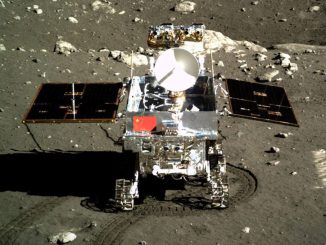
Although Comet Catalina hasn’t quite lived up to the peak magnitude predicted for it, C/2013 US10 is hovering around naked eye visibility and is likely to remain so for the following month. Although it is now receding from the Sun, Comet Catalina’s distance from Earth is still decreasing and we make our closest approach on the morning of Sunday, 17 January 2016 at a distance of 67.3 million miles (108.4 million kilometres). At that time it will be situated between M101 and Alcor in Ursa Major and therefore a circumpolar object for UK observers.
At 6am GMT on the morning of Monday, 7 December — the onset of astronomical twilight in the centre of the British Isles — planet Venus and Comet Catalina will lie just 4.5 degrees apart low to the southeast horizon in a dark sky. At the same time the following morning (Tuesday, 8 December), the brightest planet and C/2013 US10 will be fractionally closer at 4.4 degrees separation.
This means that on both 7 and 8 December it’s theoretically possible to see C/2013 US10 and Venus in the same field of view of a low-power binocular, though in practice the dazzling glare of the brightest planet will render the comet invisible. However, one need only displace Venus just outside the lower right-hand side of the field of view for the comet to be revealed (weather and local light-pollution permitting, naturally).
Cameras at the ready
Astrophotographers are in for a real treat on the morning of Tuesday, 8 December, not only due the comet’s close proximity to Venus mentioned above, but because the 26-day-old waning crescent Moon also joins the show 6.4 degrees to the lower left of the brightest planet. A typical APS-C sensor DSLR camera with a lens of 135mm focal length or less will neatly encompass the trio, though bear in mind that you need a totally unobstructed view low to the southeast. If you are close to the heart of the UK you might be able to image up until 6:30am GMT on 8 December before dawn twilight gets too bright.
Comet Catalina dates for your diary
The comet’s track is currently directed towards the north celestial pole, so its motion through eastern Virgo is largely in declination. C/2013 US10 crosses the constellation border into Boötes on Christmas Eve and it passes within ½ degree of the brightest star in the northern celestial hemisphere — magnitude +0.1 Arcturus — on the morning of New Year’s Day 2016.
The following J2000.0 topocentric coordinates of Comet Catalina for the centre of the British Isles are for 06h UT on the dates shown. They include optimistic predicted magnitudes (Mag.) with distances in astronomical units (1 AU = 92,955,807.3 miles or 149,597,870.7 kilometres) from both the Sun (r) and the Earth (Delta).

Inside the magazine
You can find out more about Comet Catalina and this month’s planetary events in the December edition of Astronomy Now in addition to a full guide to the night sky.
Never miss an issue by subscribing to the UK’s biggest astronomy magazine. Also available for iPad/iPhone and Android devices.




